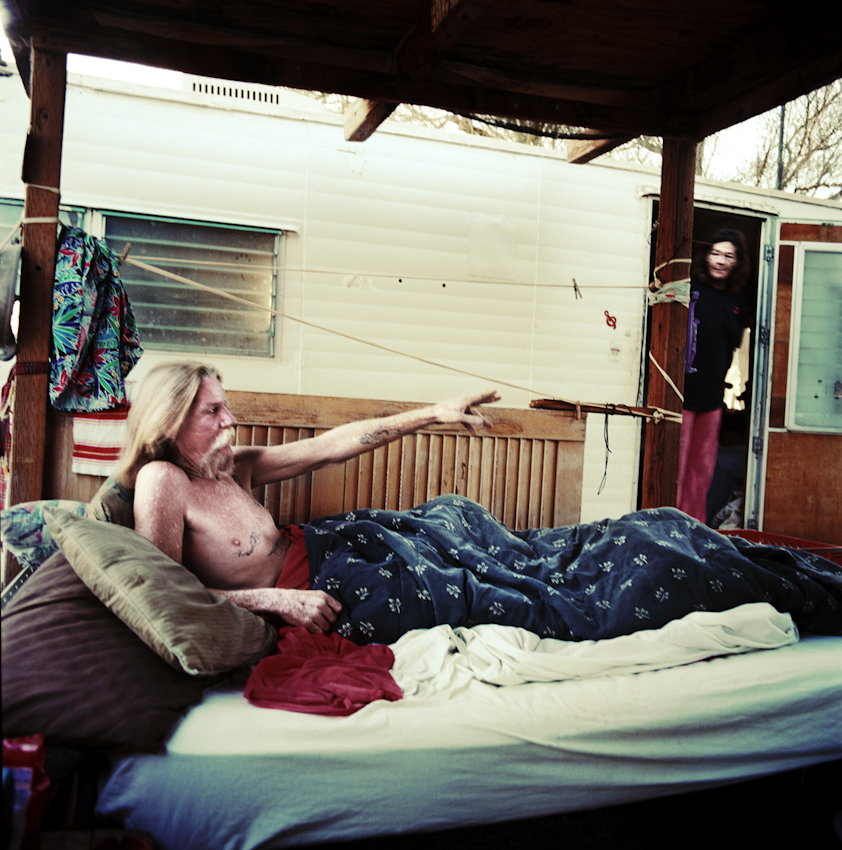Claire Martin (Australia): Selections from The Downtown East Side and Slab City
Inge Morath Award Recipient, 2010
Gallery offline – updating soon
Editor’s note: In 2010, in recognition of exceptional quality of submissions received, two applicants were selected as winners of the Inge Morath Award. Lurdes Basolí’s winning project was featured in IM Magazine in September 2010.
Both my previous works “The Downtown East Side” and “Slab City” have explored communities of people living in desperate conditions in prosperous, stable countries. The Downtown East Side is located in Vancouver, Canada. The ten block radius is home to a host of social problems including extreme poverty, an AIDS rate estimated at over 30% and the leading cause of death is overdose. Slab City is a squatters community located in the Colorado Desert in California. Residents of this community live in some of the worst conditions in the USA with no access to electricity, sewage, water or waste disposal. Mental illness, addiction and poor coping strategies are the common factors that brought these people to their respective communities. I was drawn to document these communities because the same issues have played a role in my own life.
I grew up enjoying christmas lunches with relatives who were “let out” for the day from their various institutions, shuffling around in pyjamas, dull and subdued by their anti-psychotic medications or, in the case of those who were only partially mad, talking to imaginary parrots on their shoulders. One grandmother could not be contacted on Christmas because she lived out of her car with her cats, roaming remote Australia, never staying in one place long enough for anyone to get too close. I never felt that these problems were relevant to me as a child, as my immediate family was sane and happy, that is, until my father died of cancer and my mother fell into depression and alcoholism. Fortunately for me my formative years were a little eccentric but mostly stable and happy, but it begs the question, what if these family breakdowns had happened earlier in my life? Who would I be now? Would I have developed effective coping strategies or would I have learnt by example, turned to drugs and spiralled into psychosis? When I photographed in these communities in Canada and the USA it was mostly with a broader social critique in mind, but these personal questions always informed my approach. One bad choice in life, a few twists of events or simply bad genetics and the tragic lives I have documented could be my own. I don’t have permission to turn the lens on my family, but I want to continue to explore what life is really like for Australians who are socially isolated by these problems.
I would like to explore the community of Nimbin, in rural NSW. A place that displays all the hallmarks of the previous communities I have documented, the same problems I have experienced at a familial level. Nimbin has
high addiction rates, people living below the poverty line and a melting pot of societies “drop outs” who don’t have the coping strategies to participate in Australia’s economy or social fabric in a constructive and positive way. From my previous work I saw that communities like these are more dangerous and less attractive to live in, but they serve an important purpose. They provide a blanket of emotional support for people trapped in cycles of poverty and self destruction. They provide solidarity, and a home for those who can’t function in society, where they can live without fear of judgement or persecution by their peers. I have witnessed the ugly side of these problems, now I want to explore in a more sensitive nature the realities of the people who live with such misfortune. It is important that visual media and conversation on issues of mental health, addiction and their place in developed countries like Australia are bought to the table, because they are incredibly common problems that are stigmatised and misunderstood.
Bio:
Claire Martin began her career as a social worker, and turned to photography in 2007. Since her first body of work dealing with addiction and poverty, she has published extensively, and was recently selected as an “Emerging Talent” for Reportage by Getty Images. She resides in Perth, where she is a freelance photographer.


i can’t help thinking that this dram becomes a “thing” -more than a subject. This is the paradox with the photo-journalism today. I know photography can’t change the world but it should have to say more than just only showing the problem itself..
So great! This is the photography ;)
you did open the door! tks
Claire Martin has a strong voice and unity in this project. I couldn’t take out one single picture from the whole. You have to take everything at once.
Formally powerful, surprisingly change from monochrome to color, all working arround the concept: a solid story.
I wonder how long took the research and how deep Claire had to go to get that kind of intimacy.
Congratulations!
From Argentina, Sebastian
Amazing strange portraits, thank you Claire Martin !
What an amazing subject! Those issues are so rarely documented. Interresting, and sad, and true. Bravo!
Strange to think that such stunning and thought provoking portraits can be produced from such intense poverty. A true talent.
Great work! Very impressing and authentic.
Hard stuff; pretty provocative.
How some people await their death…
Superb. Revelationary.informative and hauntingly beautiful. The humanity shines through the desperate circumstances. The poverty in so called civilised societies is all the more shocking. I applaud you for showing the horrors with such skill and compassion. Thank you. Rick
So amazing and impresive portraits !
Saludos,
Didier Petre